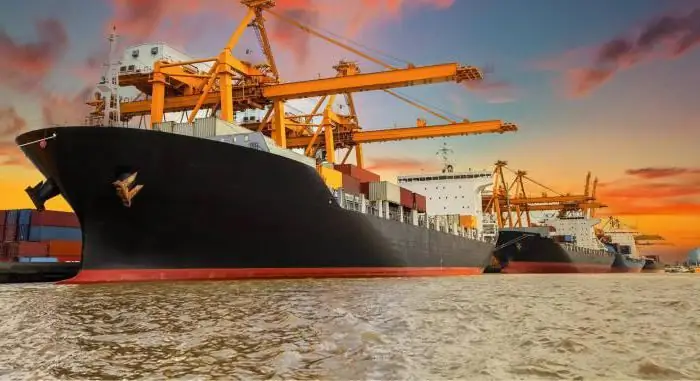2026 Author: Howard Calhoun | [email protected]. Last modified: 2025-01-24 13:10:31
At the moment, a lot of substances are used in industry, everyday life and other areas, which, if mishandled, pose a danger to human he alth and life. It is necessary to use and store them, observing certain established rules. In addition, dangerous goods must also be transported with appropriate safety measures.

In the latter case, compliance with the prescribed norms and rules is especially important. After all, transportation in itself is a rather responsible and complex process. The following classification of dangerous goods is provided in order to classify them according to the degree of danger.
- The first class includes explosives and items containing them.
- Second class - compressed gases, liquefied, cooled, dissolved under pressure. They are considered dangerous if the absolute vapor pressure is 300 kPa at a temperature of 50 g. on the Celsius scale. For chilled - critical temperature from -50 gr.
- Flammable liquids and their mixtures. In addition, these substances are classified as "dangerous goods" if the solution contains solid elements,emitting flammable vapors (flash at 61 degrees in a closed cup).
-

dangerous goods classification Flammable substances (other than explosives), which during transportation can ignite as a result of heating, friction, absorption of moisture, independent chemical transformations, belong to the fourth class.
- Organic peroxides and oxidizers. They give off flammable oxygen. In addition, under certain conditions, interacting with other substances, they can cause a fire.
- Poisonous substances. Substances capable of causing infection and poisoning in humans are also classified as dangerous goods.
- Radioactive substances (with activity from 2 nCi/g).
- Corrosive and corrosive. Anything that can cause damage to the respiratory tract, skin, eyes, is also considered dangerous goods. In addition, these are substances that cause rusting of metals, which can damage the vehicle, other cargo, etc.
- Substances that are not dangerous to humans and structures, but require careful and careful handling.

Such goods can be transported by any mode of transport: rail, road, sea, air. However, each case has its own specific rules. For example, sea transportation of dangerous goods, carried out both in bulk and in packages, provides for their mandatory labeling. It is permissible to use only high-quality packaging that can withstand the processes of loading and unloading. Bulk cargo,must be fixed in such a way as to prevent its spontaneous movement.
These are just the basic rules. There are plenty of others. In any case, dangerous goods must only be transported by personnel with the appropriate level of qualifications.
Summing up, we can say that the delivery of hazardous substances and items safe and sound without causing harm to people, animals and property is possible only if all established safety measures are observed and awareness of their classification.
Recommended:
Classes of the Nice Classification: codes, list and classifier. What is the International Classification of Goods and Services?

For the registration of each mark of new products in business, the International Classification of Goods and Services is used. At the initial stage, the applicant determines under which category his activity falls. In the future, this will be the basis for the implementation of registration procedures and determining the amount of the fee paid by the entrepreneur
A logistics company is an enterprise that provides services for the transportation, processing and storage of goods. Rating of Russian logistics companies

Many foreign companies have been hiring third parties to provide services to perform non-core functions for them for a long period of time. This scheme is called "outsourcing". It means the involvement of a third party on a reimbursable basis in order to fulfill the tasks that the company faces. Outsourcing helps businesses to be more flexible, which allows them to make good profits
Preparing goods for sale. Types and purpose of goods. Pre-sale preparation

Preparation of goods for sale includes a whole range of actions necessary for quick turnover and increase the profit of the outlet
Re-sorting of goods is a simultaneous shortage of one item of goods and a surplus of another. Accounting for sorting during inventory

When conducting an inventory at trading enterprises, shortages, surpluses, and regrading are often revealed. With the first two phenomena, everything is more or less clear: there is either a lot of this or that product, or a little. Re-sorting of goods is a rather unpleasant and difficult situation
A related profession is The concept, definition, classification of work performed, the performance of labor and related work and payment rules

What are related professions? How are they different from combining and retraining? What professions are related? Consider the example of a teacher and a pharmacist, an accountant and a lawyer. Working related professions. Three ways to master them. Motivation - leadership attitude

